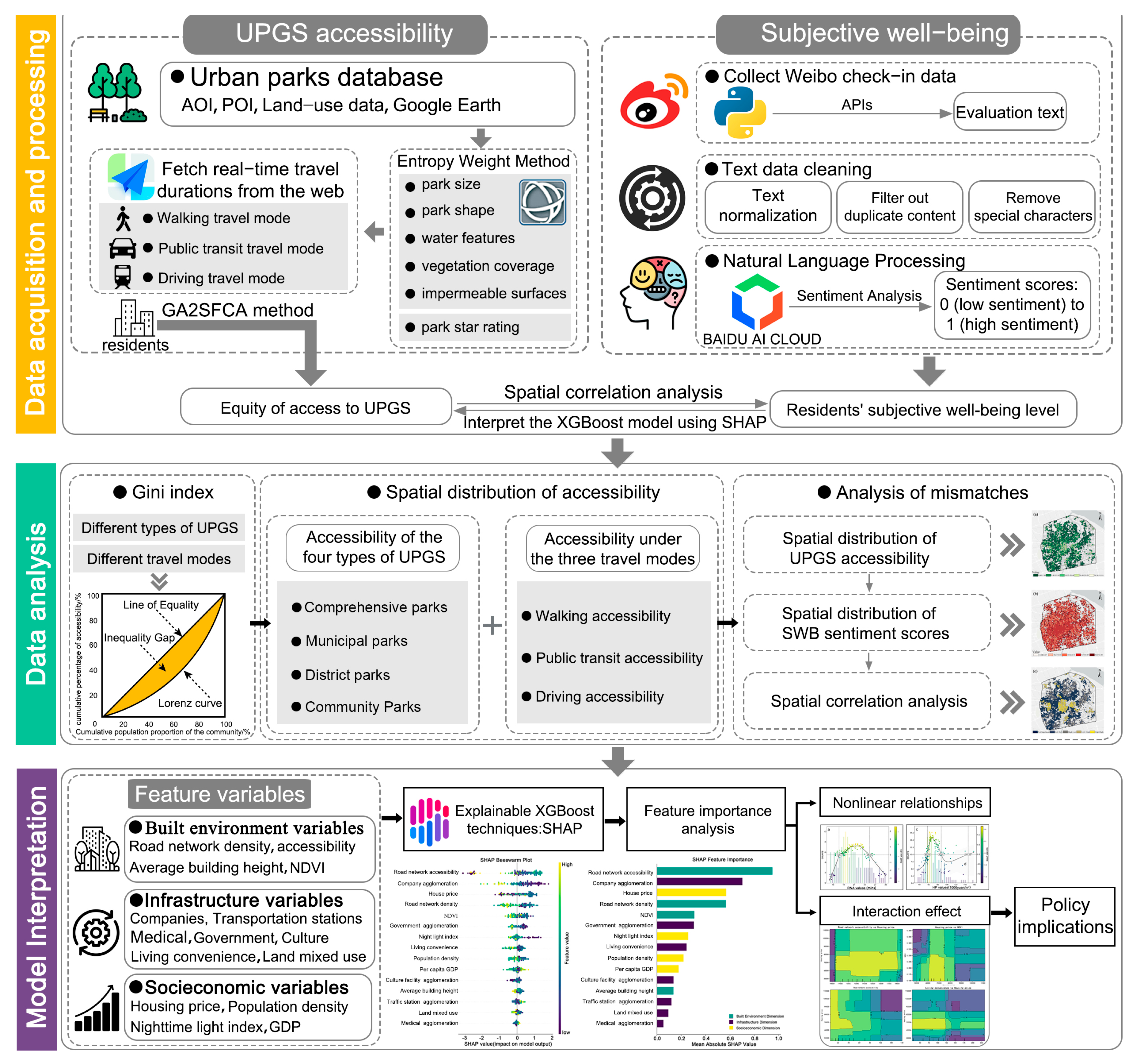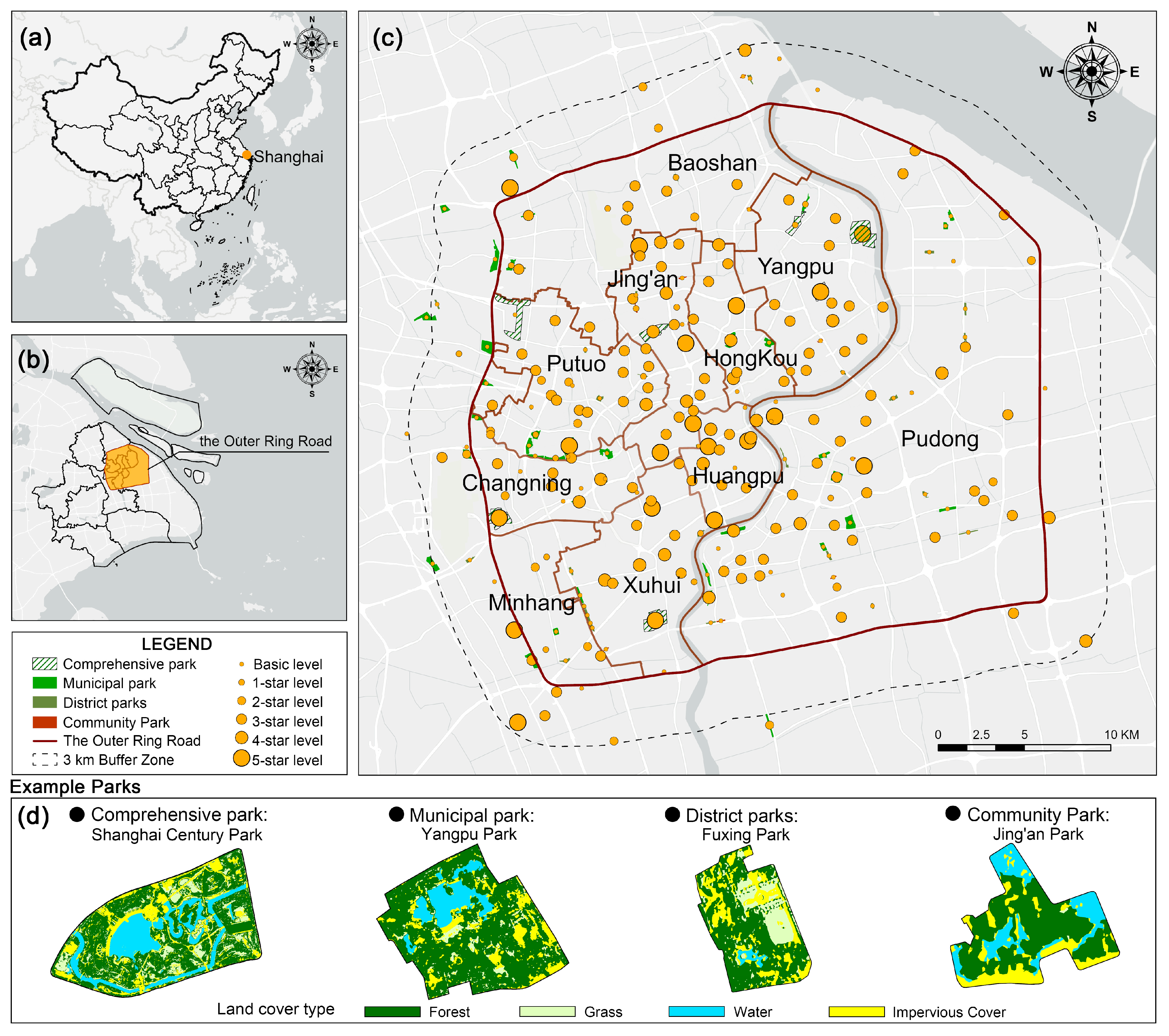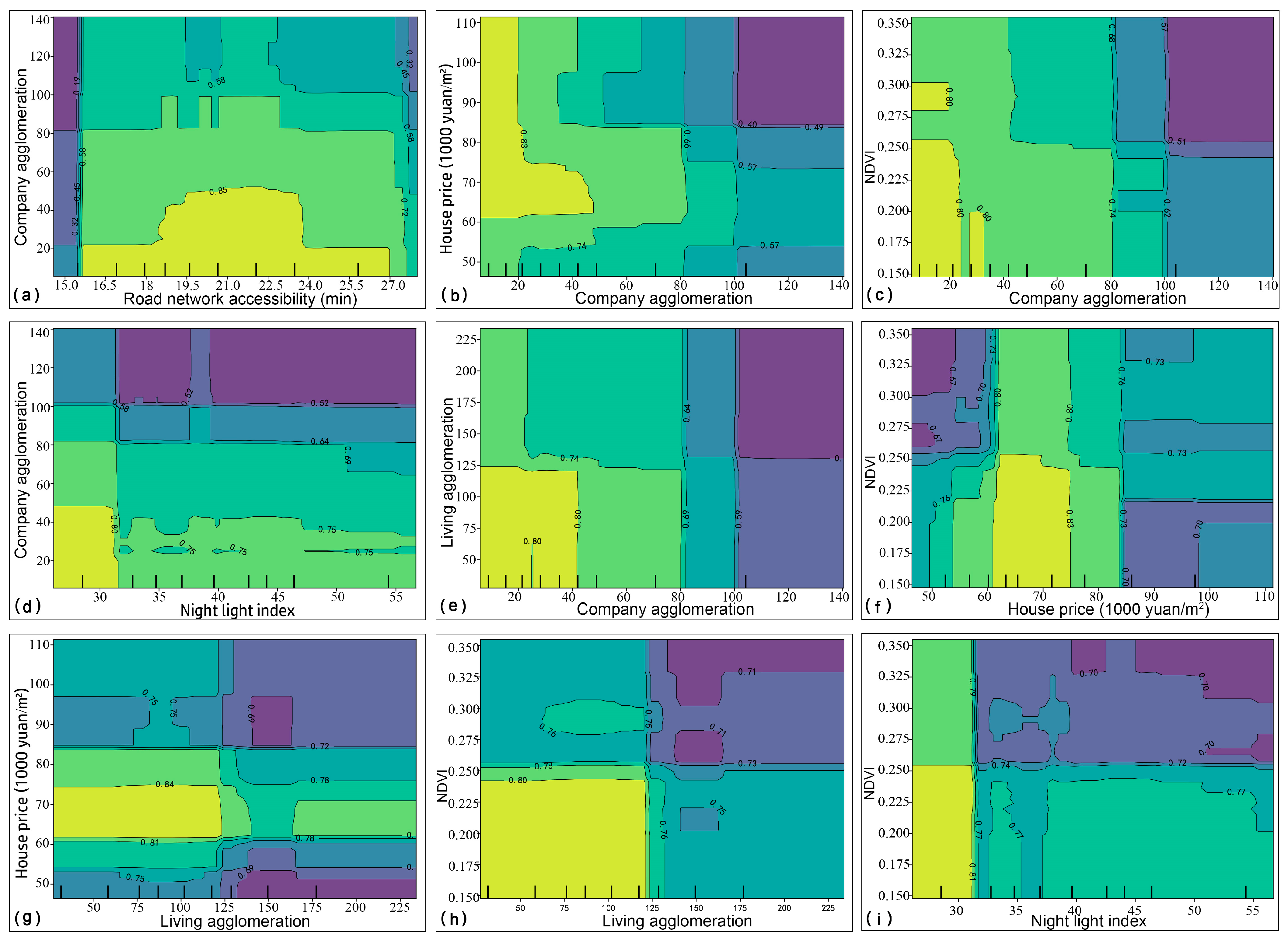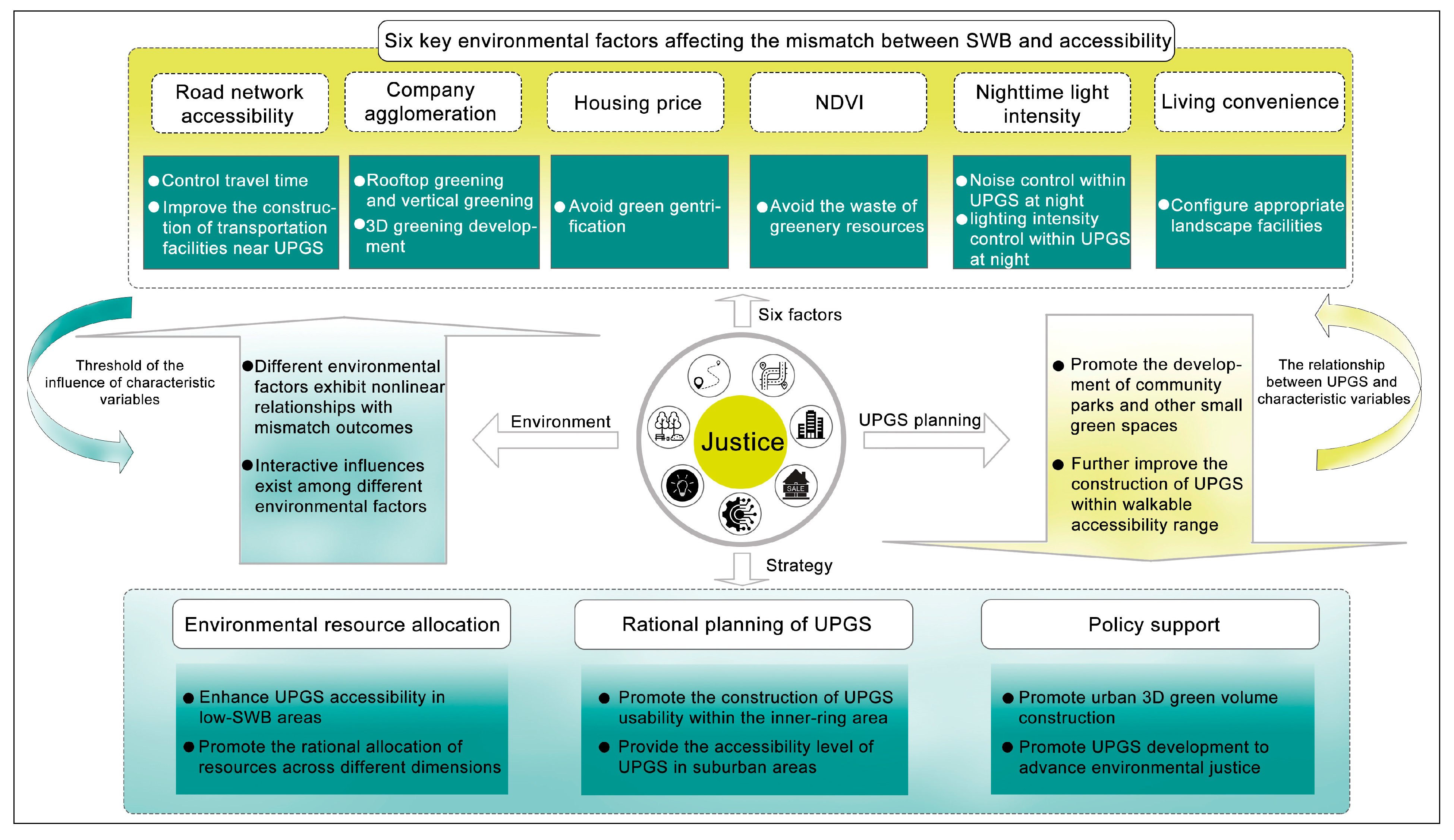Unveiling the Spatial Mismatch Between Green Space Equity and Residents’ Subjective Well-Being: An Integrated Approach Based on Machine Learning and Social Media Data
Abstract
1. Introduction
2. Materials and Methods
2.1. Study Area
2.2. Data Source and Processing
| Data Categories | Data Subtypes | Data Acquisition | Data Processing |
|---|---|---|---|
| UPGS data | AOI data | https://ditu.amap.com/ | Spatial calibration |
| Gaofen-2 satellite data | https://www.cpeos.org.cn/#/ | Supervised classification | |
| Park star rating data | https://lhsr.sh.gov.cn/ | Normalization | |
| Social media data | Weibo check-in texts | https://m.weibo.cn/ | deduplication, text normalization, and removal of null values |
| SWB | https://ai.baidu.com/ai-doc/index/NLP (accessed on 11 March 2025) | Processed using Baidu NLP | |
| Real-time navigation data | Walking travel time | https://lbs.amap.com/api/webservice/guide/api/direction (accessed on 17 April 2025) | Attribute Table Join |
| Public transit travel time | |||
| Driving travel time | |||
| Explanatory features | Road network | https://ditu.amap.com/ | OD cost matrix |
| POI | https://lbs.amap.com/ | Kernel density analysis | |
| Housing price | https://shanghai.anjuke.com/ | IDW interpolation and zonal statistics | |
| NDVI | https://modis.gsfc.nasa.gov/ | Zonal statistics | |
| Night light index | https://data.tpdc.ac.cn/ | ||
| GDP | https://www.resdc.cn/ | ||
| Population density | [48] | ||
| Building height | [49] |
2.3. Methods
2.3.1. Measuring UPGS Accessibility Based on Improved GA2SFCA
2.3.2. Spatial Autocorrelation Analysis and Mismatch Analysis
2.3.3. XGBoost Model Analysis
2.3.4. SHAP Interpretation
2.3.5. PDP Interpretation
3. Results
3.1. Spatial Equity of UPGS Under Multiple Modes of Transportation
3.2. Spatial Distribution Pattern of UPGS Accessibility
3.2.1. Spatial Distribution of UPGS Walking Accessibility
3.2.2. Spatial Distribution of UPGS Public Transit Accessibility
3.2.3. Spatial Distribution of UPGS Driving Accessibility
3.3. Spatial Correlation Analysis
3.4. Revealing Drivers of Mismatch via SHAP
3.5. Nonlinear Effects and Thresholds of Variables
3.6. Interval Analysis for Dual-Factor Optimization
4. Discussion
4.1. Equity Assessment of Green Space Planning Based on the Improved GA2SFCA
4.2. Impacts of Environmental Variables on Green Space Planning
4.3. Insights from a Globalperspective for Planning Decisions
4.4. Limitations and Future Research
5. Conclusions
Author Contributions
Funding
Data Availability Statement
Acknowledgments
Conflicts of Interest
References
- United Nations. 2024 Revision of World Population Prospects. Available online: https://www.un.org/zh/desa/UN-projects-world-population-to-peak-within-this-century-zh (accessed on 15 January 2025).
- Bhattarai, K.; Budd, D. Effects of Rapid Urbanization on the Quality of Life. In Multidimensional Approach to Quality of Life Issues: A Spatial Analysis; Sinha, B.R.K., Ed.; Springer: Singapore, 2019; pp. 327–341. [Google Scholar] [CrossRef]
- Lee, Y.-C.; Kim, K.-H. Attitudes of Citizens towards Urban Parks and Green Spaces for Urban Sustainability: The Case of Gyeongsan City, Republic of Korea. Sustainability 2015, 7, 8240–8254. [Google Scholar] [CrossRef]
- Xie, B.; An, Z.; Zheng, Y.; Li, Z. Healthy aging with parks: Association between park accessibility and the health status of older adults in urban China. Sustain. Cities Soc. 2018, 43, 476–486. [Google Scholar] [CrossRef]
- Liu, B.; Tian, Y.; Guo, M.; Tran, D.; Alwah, A.A.Q.; Xu, D. Evaluating the disparity between supply and demand of park green space using a multi-dimensional spatial equity evaluation framework. Cities 2022, 121, 103484. [Google Scholar] [CrossRef]
- Zhang, J.; Tan, P.Y. Assessment of spatial equity of urban park distribution from the perspective of supply-demand interactions. Urban For. Urban Green. 2023, 80, 127827. [Google Scholar] [CrossRef]
- Lu, Y.; Chen, R.; Chen, B.; Wu, J. Inclusive green environment for all? An investigation of spatial access equity of urban green space and associated socioeconomic drivers in China. Landsc. Urban Plan. 2024, 241, 104926. [Google Scholar] [CrossRef]
- Rigolon, A. A complex landscape of inequity in access to urban parks: A literature review. Landsc. Urban Plan. 2016, 153, 160–169. [Google Scholar] [CrossRef]
- Zhang, Y.; Zhao, J.; Mavoa, S.; Smith, M. Inequalities in urban green space distribution across priority population groups: Evidence from Tāmaki Makaurau Auckland, Aotearoa New Zealand. Cities 2024, 149, 104972. [Google Scholar] [CrossRef]
- Liu, Y.; Du, X.; Yang, W.; Zhang, G. Disparities in dynamic green exposure across residents’ mobility patterns: A case study in Chengdu. Urban For. Urban Green. 2025, 112, 128978. [Google Scholar] [CrossRef]
- Winkler, R.L.; Clark, J.A.G.; Locke, D.H.; Kremer, P.; Aronson, M.F.J.; Hoover, F.-A.; Joo, H.E.; La Rosa, D.; Lee, K.J.; Lerman, S.B.; et al. Unequal access to social, environmental and health amenities in US urban parks. Nat. Cities 2024, 1, 861–870. [Google Scholar] [CrossRef]
- Adorno, B.V.; Pereira, R.H.M.; Amaral, S. Combining spatial clustering and spatial regression models to understand distributional inequities in access to urban green spaces. Landsc. Urban Plan. 2025, 256, 105297. [Google Scholar] [CrossRef]
- Viinikka, A.; Tiitu, M.; Heikinheimo, V.; Halonen, J.I.; Nyberg, E.; Vierikko, K. Associations of neighborhood-level socioeconomic status, accessibility, and quality of green spaces in Finnish urban regions. Appl. Geogr. 2023, 157, 102973. [Google Scholar] [CrossRef]
- Sun, Z.; Lin, J.; Ta, N.; Wu, J. Gender differences in the impact of green space exposure on life satisfaction. Cities 2025, 158, 105678. [Google Scholar] [CrossRef]
- Lu, J.; Li, L.; Wang, W. Assessing accessibility and environmental equity in the context of sustained aging: Pathways for age-friendly urban park planning. Urban For. Urban Green. 2025, 108, 128768. [Google Scholar] [CrossRef]
- Talen, E. The social equity of urban service distribution: An exploration of park access in pueblo, colorado, and macon, georgia. Urban Geogr. 1997, 18, 521–541. [Google Scholar] [CrossRef]
- Hillier, B.; Hanson, J.; Grajewski, T.; Xu, J. Natural Movement: Or, Configuration and Attraction in Urban Pedestrian Movement. Environ. Plan. B Plan. Des. 1993, 20, 29–66. [Google Scholar] [CrossRef]
- Wang, S.; Yung, E.H.K.; Sun, Y. Effects of open space accessibility and quality on older adults′ visit: Planning towards equal right to the city. Cities 2022, 125, 103611. [Google Scholar] [CrossRef]
- Comber, A.; Brunsdon, C.; Green, E. Using a GIS-based network analysis to determine urban greenspace accessibility for different ethnic and religious groups. Landsc. Urban Plan. 2008, 86, 103–114. [Google Scholar] [CrossRef]
- Talen, E.; Anselin, L. Assessing spatial equity: An evaluation of measures of accessibility to public playgrounds. Environ. Plan. A 1998, 30, 595–613. [Google Scholar] [CrossRef]
- Dai, D. Racial/ethnic and socioeconomic disparities in urban green space accessibility: Where to intervene? Landsc. Urban Plan. 2011, 102, 234–244. [Google Scholar] [CrossRef]
- Li, C.; Wang, J. Using an age-grouped Gaussian-based two-step floating catchment area method (AG2SFCA) to measure walking accessibility to urban parks: With an explicit focus on elderly. J. Transp. Geogr. 2024, 114, 103772. [Google Scholar] [CrossRef]
- Liang, H.; Yan, Q.; Yan, Y.; Zhang, Q. Using an improved 3SFCA method to assess inequities associated with multimodal accessibility to green spaces based on mismatches between supply and demand in the metropolitan of Shanghai, China. Sustain. Cities Soc. 2023, 91, 104456. [Google Scholar] [CrossRef]
- Fang, D.; Liu, D.; Kwan, M.-P. Evaluating spatial variation of accessibility to urban green spaces and its inequity in Chicago: Perspectives from multi-types of travel modes and travel time. Urban For. Urban Green. 2025, 104, 128593. [Google Scholar] [CrossRef]
- Chen, H.; Yun, Z.; Xie, L.; Dawodu, A. Spatial disparities in urban park accessibility: Integrating real-time traffic data and housing prices in Ningbo, China. Urban For. Urban Green. 2024, 100, 128484. [Google Scholar] [CrossRef]
- Diener, E. Subjective well-being. Psychol. Bull. 1984, 95, 542–575. [Google Scholar] [CrossRef]
- Cheng, Y.; Browning, M.H.E.M.; Zhao, B.; Qiu, B.; Wang, H.; Zhang, J. How can urban green space be planned for a ‘happy city’? Evidence from overhead- to eye-level green exposure metrics. Landsc. Urban Plan. 2024, 249, 105131. [Google Scholar] [CrossRef]
- Patino, J.E.; Martinez, L.; Valencia, I.; Duque, J.C. Happiness, life satisfaction, and the greenness of urban surroundings. Landsc. Urban Plan. 2023, 237, 104811. [Google Scholar] [CrossRef]
- Rao, J.; Ma, J.; Dong, G. How mobility-based exposure to green space and environmental pollution influence individuals’ wellbeing? A structural equation analysis through the lens of environmental justice. Landsc. Urban Plan. 2024, 252, 105199. [Google Scholar] [CrossRef]
- Twohig-Bennett, C.; Jones, A. The health benefits of the great outdoors: A systematic review and meta-analysis of greenspace exposure and health outcomes. Env. Res. 2018, 166, 628–637. [Google Scholar] [CrossRef]
- Reyes-Riveros, R.; Altamirano, A.; De La Barrera, F.; Rozas-Vásquez, D.; Vieli, L.; Meli, P. Linking public urban green spaces and human well-being: A systematic review. Urban For. Urban Green. 2021, 61, 127105. [Google Scholar] [CrossRef]
- Zhao, X.; Lu, Y.; Huang, W.; Lin, G. Assessing and interpreting perceived park accessibility, usability and attractiveness through texts and images from social media. Sustain. Cities Soc. 2024, 112, 105619. [Google Scholar] [CrossRef]
- Huibers, M.J.; de Graaf, L.E.; Peeters, F.P.; Arntz, A. Does the weather make us sad? Meteorological determinants of mood and depression in the general population. Psychiatry Res. 2010, 180, 143–146. [Google Scholar] [CrossRef] [PubMed]
- Plunz, R.A.; Zhou, Y.; Carrasco Vintimilla, M.I.; McKeown, K.; Yu, T.; Uguccioni, L.; Sutto, M.P. Twitter sentiment in New York City parks as measure of well-being. Landsc. Urban Plan. 2019, 189, 235–246. [Google Scholar] [CrossRef]
- Cui, N.; Malleson, N.; Houlden, V.; Yan, Y.; Comber, A. Using Twitter to understand spatial-temporal changes in urban green space topics based on structural topic modelling. Cities 2025, 157, 105601. [Google Scholar] [CrossRef]
- Derks, D.; Fischer, A.H.; Bos, A.E.R. The role of emotion in computer-mediated communication: A review. Comput. Hum. Behav. 2008, 24, 766–785. [Google Scholar] [CrossRef]
- Martí, P.; Serrano-Estrada, L.; Nolasco-Cirugeda, A. Social Media data: Challenges, opportunities and limitations in urban studies. Comput. Environ. Urban Syst. 2019, 74, 161–174. [Google Scholar] [CrossRef]
- Bertram, C.; Rehdanz, K. The role of urban green space for human well-being. Ecol. Econ. 2015, 120, 139–152. [Google Scholar] [CrossRef]
- Sharifi, F.; Nygaard, A.; Stone, W.M.; Levin, I. Accessing green space in Melbourne: Measuring inequity and household mobility. Landsc. Urban Plan. 2021, 207, 104004. [Google Scholar] [CrossRef]
- Rui, J. Green disparities, happiness elusive: Decoding the spatial mismatch between green equity and the happiness from vulnerable perspectives. Cities 2025, 163, 106063. [Google Scholar] [CrossRef]
- De Luca, C.; Calcagni, F.; Tondelli, S. Assessing distributional justice around Cultural Ecosystem Services (CES) provided by urban green areas: The case of Bologna. Urban For. Urban Green. 2024, 101, 128556. [Google Scholar] [CrossRef]
- Zheng, Y.; Chen, X.; Zhang, M.; Zhu, R.; Jin, Y. Darker nights, happier lives? The impact of urban green space night-time accessibility on residents′ subjective happiness: A case study of the main urban area of Hangzhou. Cities 2026, 169, 106510. [Google Scholar] [CrossRef]
- Shanghai Municipal Bureau of Statistics. Shanghai Statistical Yearbook 2024. Available online: https://tjj.sh.gov.cn/tjnj/20250331/9f8ec62cc2234485b0aa411b8d967c37.html (accessed on 5 May 2025).
- Xiao, Y.; Cen, L. Do new urban parks really improve green equity? A longitudinal analysis of Shanghai (2000–2020). Landsc. Urban Plan. 2026, 265, 105519. [Google Scholar] [CrossRef]
- Ministry of Housing and Urban-Rural Development of China. Standard for classification of urban green space (CJJ/T85-2017). Available online: https://www.mohurd.gov.cn/gongkai/zc/wjk/art/2018/art_17339_236545.html (accessed on 3 May 2025).
- Shanghai Bureau of Planning and Natural Resources. Shanghai Ecological Space Special Plan (2021–2035). Available online: https://ghzyj.sh.gov.cn/zxgh/20231009/129e4b3c04104159bc2d424d5e24c1bb.html (accessed on 3 May 2025).
- Wang, Z.; Li, Z.; Cheng, H. The equity of urban park green space accessibility in large Chinese cities: A case study of Wuhan City. Prog. Geogr. 2022, 41, 621–635. [Google Scholar] [CrossRef]
- Chen, Y.; Xu, C.; Ge, Y.; Zhang, X.; Zhou, Y. A 100 m gridded population dataset of China’s seventh census using ensemble learning and big geospatial data. Earth Syst. Sci. Data 2024, 16, 3705–3718. [Google Scholar] [CrossRef]
- Wu, W.-B.; Ma, J.; Banzhaf, E.; Meadows, M.E.; Yu, Z.-W.; Guo, F.-X.; Sengupta, D.; Cai, X.-X.; Zhao, B. A first Chinese building height estimate at 10 m resolution (CNBH-10 m) using multi-source earth observations and machine learning. Remote Sens. Environ. 2023, 291, 113578. [Google Scholar] [CrossRef]
- Guo, R.; Ann Diehl, J.; Zhang, R.; Wang, H. Spatial equity of urban parks from the perspective of recreational opportunities and recreational environment quality: A case study in Singapore. Landsc. Urban Plan. 2024, 247, 105065. [Google Scholar] [CrossRef]
- Yaxian, G.; Wei, L.; Gang, H.; Shuhang, Z. Evaluation of industrial ecological security in industrial transformation demonstration area based on spatiotemporal differentiation. Geomat. Nat. Hazards Risk 2022, 13, 1422–1440. [Google Scholar] [CrossRef]
- Zhang, J. Inequalities in the quality and proximity of green space exposure are more pronounced than in quantity aspect: Evidence from a rapidly urbanizing Chinese city. Urban For. Urban Green. 2023, 79, 127811. [Google Scholar] [CrossRef]
- Wang, H. Mapping Walking Accessibility, Bus Availability, and Car Dependence: A Case Study of Xiamen, China. In Spatial Planning and Sustainable Development: Approaches for Achieving Sustainable Urban Form in Asian Cities; Kawakami, M., Shen, Z.-j., Pai, J.-t., Gao, X.-l., Zhang, M., Eds.; Springer: Dordrecht, The Netherlands, 2013; pp. 249–267. [Google Scholar] [CrossRef]
- Chen, Y.; Yue, W.; La Rosa, D. Which communities have better accessibility to green space? An investigation into environmental inequality using big data. Landsc. Urban Plan. 2020, 204, 103919. [Google Scholar] [CrossRef]
- Chen, T.; Guestrin, C. XGBoost. In Proceedings of the 22nd ACM SIGKDD International Conference on Knowledge Discovery and Data Mining, San Francisco, CA, USA, 13–17 August 2016; pp. 785–794. [Google Scholar] [CrossRef]
- Lundberg, S.M.; Lee, S.-I. A unified approach to interpreting model predictions. In Proceedings of the 31st International Conference on Neural Information Processing Systems, Long Beach, CA, USA, 4–9 December 2017; pp. 4768–4777. [Google Scholar] [CrossRef]
- Friedman, J.H. Greedy function approximation: A gradient boosting machine. Ann. Stat. 2001, 29, 1189–1232. [Google Scholar] [CrossRef]
- Zhao, X.; Yang, H.; Yao, Y.; Qi, H.; Guo, M.; Su, Y. Factors affecting traffic risks on bridge sections of freeways based on partial dependence plots. Phys. A Stat. Mech. Its Appl. 2022, 598, 127343. [Google Scholar] [CrossRef]
- Sharma, G.; Patil, G.R. Urban spatial structure and equity for urban services through the lens of accessibility. Transp. Policy 2024, 146, 72–90. [Google Scholar] [CrossRef]
- Tian, D.; Wang, J.; Xia, C.; Zhang, J.; Zhou, J.; Tian, Z.; Zhao, J.; Li, B.; Zhou, C. The relationship between green space accessibility by multiple travel modes and housing prices: A case study of Beijing. Cities 2024, 145, 104694. [Google Scholar] [CrossRef]
- Jiang, B.; Li, J.; Gong, P.; Webster, C.; Schumann, G.; Liu, X.; Suppakittpaisarn, P. A generalized relationship between dose of greenness and mental health response. Nat. Cities 2025, 2, 739–748. [Google Scholar] [CrossRef]
- Su, L.; Jia, J. The relationship between nighttime light intensity and GDP in Shanghai districts. J. Comput. Methods Sci. Eng. 2023, 23, 3–8. [Google Scholar] [CrossRef]
- Chepesiuk, R. Missing the Dark: Health Effects of Light Pollution. Environ. Health Perspect. 2009, 117, A20–A27. [Google Scholar] [CrossRef] [PubMed]
- Li, Q.; Wu, R.; Zhu, P. Quality or quantity of urban greenery: Which matters more to mental health? Evidence from housing prices in the Pearl River Delta. Landsc. Urban Plan. 2025, 263, 105438. [Google Scholar] [CrossRef]
- Wu, L.; Kim, S.K. Does socioeconomic development lead to more equal distribution of green space? Evidence from Chinese cities. Sci. Total Environ. 2021, 757, 143780. [Google Scholar] [CrossRef] [PubMed]
- Zhang, W.; Li, S.; Gao, Y.; Liu, W.; Jiao, Y.; Zeng, C.; Gao, L.; Wang, T. Travel changes and equitable access to urban parks in the post COVID-19 pandemic period: Evidence from Wuhan, China. J. Environ. Manag. 2022, 304, 114217. [Google Scholar] [CrossRef]
- Bakhtsiyarava, M.; Moran, M.; Ju, Y.; Zhou, Y.; Rodriguez, D.A.; Dronova, I.; de Fatima Rodrigues Pereira de Pina, M.; de Matos, V.P.; Skaba, D.A. Potential drivers of urban green space availability in Latin American cities. Nat. Cities 2024, 1, 842–852. [Google Scholar] [CrossRef]
- Liu, D.; Kwan, M.-P.; Yang, Z.; Kan, Z. Comparing subjective and objective greenspace accessibility: Implications for real greenspace usage among adults. Urban For. Urban Green. 2024, 96, 128335. [Google Scholar] [CrossRef]
- Xu, Z.; Marini, S.; Mauro, M.; Maietta Latessa, P.; Grigoletto, A.; Toselli, S. Associations Between Urban Green Space Quality and Mental Wellbeing: Systematic Review. Land 2025, 14, 381. [Google Scholar] [CrossRef]
- Ugolini, F.; Massetti, L.; Calaza-Martínez, P.; Cariñanos, P.; Dobbs, C.; Krajter Ostoić, S.; Marin, A.M.; Pearlmutter, D.; Saaroni, H.; Šaulienė, I.; et al. Understanding the benefits of public urban green space: How do perceptions vary between professionals and users? Landsc. Urban Plan. 2022, 228, 104575. [Google Scholar] [CrossRef]
- Navarrete-Hernandez, P.; Kiarostami, N.; Yang, D.; Ozcakir, A. Green Enough? A dose-response curve of the impact of street greenery levels and types on perceived happiness. Landsc. Urban Plan. 2024, 251, 105130. [Google Scholar] [CrossRef]
- Shan, L.; He, S. The role of peri-urban parks in enhancing urban green spaces accessibility in high-density contexts: An environmental justice perspective. Landsc. Urban Plan. 2025, 254, 105244. [Google Scholar] [CrossRef]
- Zhang, K.; Chen, M. Multi-method analysis of urban green space accessibility: Influences of land use, greenery types, and individual characteristics factors. Urban For. Urban Green. 2024, 96, 128366. [Google Scholar] [CrossRef]
- Assaad, R.H.; Jezzini, Y. Green gentrification vulnerability index (GGVI): A novel approach for identifying at-risk communities and promoting environmental justice at the census-tract level. Cities 2024, 148, 104858. [Google Scholar] [CrossRef]
- Wu, L.; Rowe, P.G. Green space progress or paradox: Identifying green space associated gentrification in Beijing. Landsc. Urban Plan. 2022, 219, 104321. [Google Scholar] [CrossRef]
- Wang, J.; Hu, Y.; Zhang, X. Is green gentrification a pernicious paradox in the urban greening process? Land Use Policy 2025, 158, 107766. [Google Scholar] [CrossRef]
- Xie, X.; Huang, W.; Liu, X.; Gou, Z. A framework for green space equity in central business districts: Exposure assessment and comparative analysis for office workers across global cities. Cities 2025, 167, 106397. [Google Scholar] [CrossRef]
- Cheng, Y.; Zhang, J.; Wei, W.; Zhao, B. Effects of urban parks on residents’ expressed happiness before and during the COVID-19 pandemic. Landsc. Urban Plan. 2021, 212, 104118. [Google Scholar] [CrossRef] [PubMed]
- Jianzhong, H.; Gangyu, H.; Yuhan, L.; Tianran, Z.; Siling, C.; Yishuai, Z. Study on the characteristics of weekend trips to three types of non-work destinations based on multi-source data: A case study of Shanghai, China. Front. Urban Rural Plan. 2024, 2, 25. [Google Scholar] [CrossRef]
- Yang, C.; Zhang, Y. Public emotions and visual perception of the East Coast Park in Singapore: A deep learning method using social media data. Urban For. Urban Green. 2024, 94, 128285. [Google Scholar] [CrossRef]
- Tan, X.; Huang, B.; Batty, M.; Li, W.; Wang, Q.R.; Zhou, Y.; Gong, P. The spatiotemporal scaling laws of urban population dynamics. Nat. Commun. 2025, 16, 2881. [Google Scholar] [CrossRef] [PubMed]









| Hyperparameter | Value Range | Optimal Parameter Combination |
|---|---|---|
| learning_rate | [0.01, 0.05, 0.1] | 0.1 |
| max_depth | [3, 6, 9] | 6 |
| n_estimators | [50, 100, 200] | 100 |
| subsample | [0.8, 0.9, 1.0] | 1.0 |
| colsample_bytree | [0.8, 0.9, 1.0] | 0.8 |
Disclaimer/Publisher’s Note: The statements, opinions and data contained in all publications are solely those of the individual author(s) and contributor(s) and not of MDPI and/or the editor(s). MDPI and/or the editor(s) disclaim responsibility for any injury to people or property resulting from any ideas, methods, instructions or products referred to in the content. |
© 2025 by the authors. Licensee MDPI, Basel, Switzerland. This article is an open access article distributed under the terms and conditions of the Creative Commons Attribution (CC BY) license (https://creativecommons.org/licenses/by/4.0/).
Share and Cite
Gong, H.; Sun, L. Unveiling the Spatial Mismatch Between Green Space Equity and Residents’ Subjective Well-Being: An Integrated Approach Based on Machine Learning and Social Media Data. Land 2025, 14, 2205. https://doi.org/10.3390/land14112205
Gong H, Sun L. Unveiling the Spatial Mismatch Between Green Space Equity and Residents’ Subjective Well-Being: An Integrated Approach Based on Machine Learning and Social Media Data. Land. 2025; 14(11):2205. https://doi.org/10.3390/land14112205
Chicago/Turabian StyleGong, Hao, and Leilei Sun. 2025. "Unveiling the Spatial Mismatch Between Green Space Equity and Residents’ Subjective Well-Being: An Integrated Approach Based on Machine Learning and Social Media Data" Land 14, no. 11: 2205. https://doi.org/10.3390/land14112205
APA StyleGong, H., & Sun, L. (2025). Unveiling the Spatial Mismatch Between Green Space Equity and Residents’ Subjective Well-Being: An Integrated Approach Based on Machine Learning and Social Media Data. Land, 14(11), 2205. https://doi.org/10.3390/land14112205






